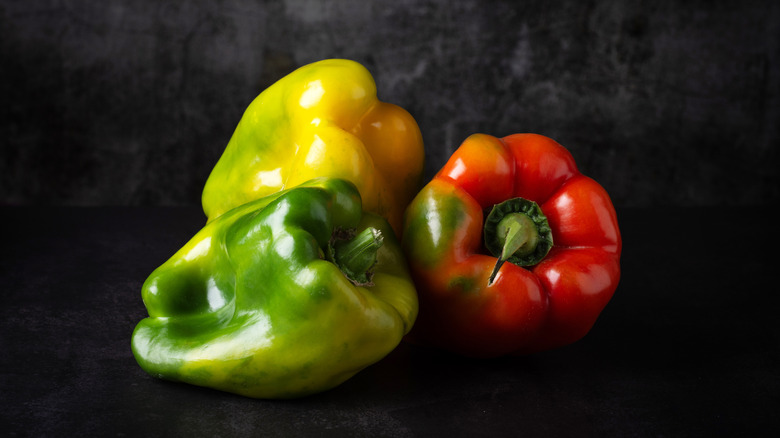This Gordon Ramsay Pro-Tip Makes Cutting Bell Peppers A Breeze
Bell peppers are a delicious, versatile fruit (botanically they're fruit, though in the culinary world, many of us treat them like veggies) that goes great in a wide variety of recipes. Yet, cutting a bell pepper up can be annoying and lead to seeds all over your cutting board. Fortunately for us, celebrity chef Gordon Ramsay has oodles of cooking pro tips for everything from mincing garlic with a bit of salt to chopping that perfect bell pepper. Once you cut a pepper like Ramsay, you'll never go back.
To cut a pepper like Gordon Ramsay, first slice the top off to create a flat edge, then hold the pepper on the cutting board upside-down and cut top to bottom down the length. Creating that flat edge base gives you a steady, firm foundation to work with, which allows you to cut easier, faster, and safer with fewer mistakes — and makes it simple to avoid the pithy lump of seeds in the middle. So, next time you make chicken and green chile quesadillas, take a page out of Ramsay's book and prep the peppers upside-down.
Before you can chop those peppers, though, they need to be fresh. In Ramsay's words, the perfect pepper is "smooth and firm, without a wrinkle in sight." If a bell pepper shows any signs of spoilage, it may be better consigned to your compost pile. Fun fact: a bell pepper's color really does affect how long it stays fresh. Generally speaking, green peppers last the longest compared to their yellow, orange, or red counterparts.
Chopping peppers Ramsay-style
Of course, positioning and freshness aren't all Gordon Ramsay has to say about cutting the perfect bell pepper. Once you have your cut pepper, when you're slicing it thinner for use in a recipe, cut it with the skin side down. The skin is tougher and harder to cut than the inner flesh, so cutting with the skin down will allow you to chop through easier and faster.
While cutting, Ramsay emphasizes the importance of avoiding the white parts, also called the pith. Pith is bitter and unappetizing, so cut carefully around it while you're preparing your pepper. That said, not all agree on the bitterness, as some online commenters have claimed that it's merely bland. Still, you'll probably want to trim away any of that white pith on your pepper slices before you continue.
Finally, any chef will tell you that precision and safety are the most important things when handling a knife, and Ramsay is no different. While chopping your pepper, protect your fingers using your last knuckles (the ones closest to the fingertips), letting them act as a guide. Let the knife do the work, and don't worry about speed as much as control. While you're at it, be sure your knives are properly sharp, as dull ones are more dangerous, given that they're prone to catching and skipping around.

